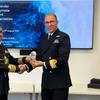MarineNews: How long has your current safety training program been in place?
Tom Knode: Halliburton Energy Services and its predecessor companies have conducted safety training for employees for at least the past three decades.
MN: How much money is spent annually on the safety program?
Knode: The safety program, including safety professionals, equipment, training, and auditing, runs into the tens of millions annually.
MN: Is the program conducted in-house? Or are the employees sent to an off-site facility?
Knode: The majority of safety training is conducted in-house.
MN: If in-house, is the program taught by staff members? Or is a third party brought in for instruction?
Knode: The training is primarily conducted by our training and safety professionals. In addition to traditional classes, computer-based training is gaining acceptance as a preferred alternative for selected topics and courses (e.g. re-fresher training). This is especially useful for those working offshore who may not be able to routinely attend facility safety meetings or classes.
MN: If off-site, which facility do you use?
Knode: We use facilities that have pools for offshore water survival and some H2S Train-the-Trainer.
MN: How often are training program "classes" held? What percentage of the employee base participates at any one time?
Knode: Around the world there are classes being conducted weekly. At any one time the percentage of employees participating is relatively small.
MN: Are the classes mandatory? Are there optional classes for employees interested in getting more training?
Knode: Requirements for attendance are set based on the job duties of person. Attendance is mandatory and prescribed for each job title. People who are interested in more safety information can attend additional training classes as well as participate in facility safety teams.
MN: What penalties exist for non-compliance to the safety policies, or non-attendance to the sessions?
Knode: Progressive discipline is applied to those violating safety policies. Bonuses and merit increases can also be withheld or reduced when policy is violated or safety competency requirements were not met.
MN: What steps are taken to ensure the policies and skills learned in training are kept up during the workday? Are there random checks? Weekly meetings?
Knode: There are daily, weekly and monthly safety meetings held at the facilities. Pre and post-job safety meetings are held on the well-site. Hazard observation cards are used to identify unsafe acts or conditions. Routine inspections of the facility and work-sites are conducted by different levels of management. Each of these reinforce the competencies gained in the safety training.
MN: What does your training program currently entail? What courses and skills are taught and why?
Knode: Courses such as offshore survival, hazard communication, energized fluids, confined space, back injury prevention, hearing conservation, PPE, H2S, respiratory protection, fire prevention & control, fall protection, defensive driving, environmental issues/incident reporting, first aid/CPR, bloodborne pathogens protection, radiation safety, effects of drug & alcohol, and others are typically required, again based on job duties. Additionally, risk management, causal analysis and hazard observation are taught to our employees to enable them to identify risks and implement appropriate controls as they perform their jobs.
They are also taught how to utilize documentation of processes in our integrated management system. This integrated management system, The Halliburton Management System, identifies safety as well as environmental risks within a given process and then includes a risk analysis that prescribes the controls and countermeasures used to mitigate the risk.
The employees are instructed in the use of our management of change tool, Correction, Prevention and Improvement (CPI). This tool is a web-based database and system that documents issues, assigns responsibility and track actions. A CPI can be used for health, safety or environmental issues, along with service quality, manufacturing or process-related topics.
MN: Are there changes planned for your program in the next 1-5 years? New courses or skills added, or dropped?
Knode: We will move towards a behavioral-based safety program that will require training for observation of safe behaviors. A migration away from traditional classroom training towards computer-based training for those course that can be delivered via distance learning is underway. Computer skills will have to be developed in the workforce so that this system can be fully utilized. Language and other barriers that do not manifest themselves in the classrooms will be brought out during the implementation of the new training.
MN: How has your company's operations changed (for better or worse) as a result of a safety program?
Knode: There is no doubt the operations are better with a strong safety program. Safety is an integral part to how business is conducted and without attention paid to that detail failures in all areas will occur. The training program allows us to continuously re-inforce the safety issues and expectations.
Tom Knode is the HSE Manager for the Business Development segment of Halliburton Energy Services.
Sponsored Content
MSC Sets a New Standard for Time Off in 2025, Plus Earn a $44,345 Bonus as an Able Seaman!

The Future of the Advanced Measurement Industry: A Vision of Precision, Safety, and Reliability

August 2025
 Read the Magazine
Read the Magazine

 Read the Magazine
Read the Magazine
This issue sponsored by:

Corn Belt Ports: Connecting America’s Heartland to Global Markets
Subscribe for
Maritime Reporter E-News
Maritime Reporter E-News is the maritime industry's largest circulation and most authoritative ENews Service, delivered to your Email five times per week









